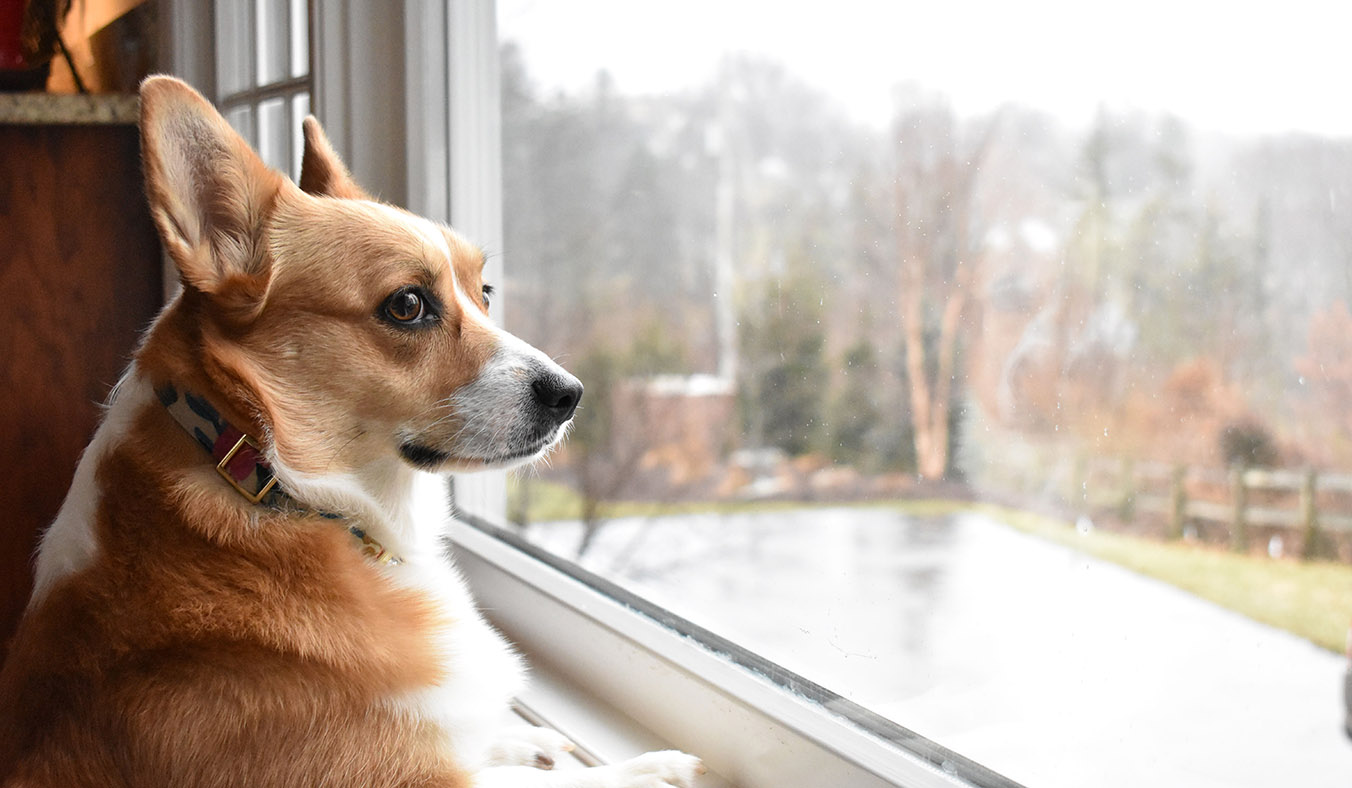During that time, every morning when I left home, low whimpers would echo through the house. At the sound of the keys jingling or the door lock turning, I could feel those eyes staring at my back—filled with worry, unease, and a hint of resentment. I closed the door, but the image of a restless figure pacing in the corner would haunt me, along with the chewed-up slippers, torn cushions, and scratch marks behind the sofa I’d later find upon my return.
That wasn’t “naughtiness”—it was separation anxiety, an emotional issue I once thought only humans experienced. It wasn’t until I began paying attention to my pet’s emotional world that I realized they’re far more sensitive to “goodbyes” than I had ever imagined.
1. What Is Pet Separation Anxiety?
Separation anxiety refers to the intense distress pets experience when separated from their primary attachment figure. It’s not “clinginess” or “bad behavior”—it’s a stress response rooted in a deep sense of insecurity.
Common signs include:
- Becoming restless, following you around, or whining when you prepare to leave.
- Exhibiting excessive barking, howling, destructive chewing, or loss of bladder/bowel control once you’re gone.
- Refusing food and water, or appearing listless during extended periods alone.
- Becoming overly excited upon your return, unwilling to leave your side even for a moment.
Separation anxiety can affect any pet—regardless of breed or age. Dogs often show more visible signs, but cats express it too, sometimes by hiding, refusing food, or even deliberately soiling your bed.
2. What Triggers Separation Anxiety in Pets?
Looking back, every emotional breakdown my pet experienced was closely tied to either environmental changes or shifts in relationship dynamics. The most common triggers include:
1. Moving or Environmental Changes
To humans, moving is a life adjustment; to pets, it’s the upheaval of their entire world. Familiar smells, routes, and sunlit corners disappear, leaving them insecure.
2. Sudden Changes in Your Daily Routine
Transitioning from working from home to commuting again means a sudden increase in alone time, which can be disorienting for your pet.
3. A Household Member Leaving or a New One Arriving
Whether someone moves out or a new person or animal joins, it disrupts your pet’s perception of the household structure, causing stress.

4. Frequent Short-Term Absences or Trips
Even if you’re only gone for a few hours, repeated departures and returns can lead to anxious attachment behaviors.
5. History of Abandonment, Fostering, or Rehoming
Pets with past trauma are more likely to develop severe separation anxiety.
3. How I Realized It Was Anxiety, Not Misbehavior
We often dismiss our pets’ strange behaviors as “naughty” or “revenge,” but if you truly observe them, the emotional pattern becomes clear.
I once installed a small camera before leaving. What I saw wasn’t destruction—it was heartbreaking: my pet stood silently at the door for minutes, then wandered around sniffing my clothes, finally curling up in a corner, eyes fixed on the entrance.
That moment filled me with guilt. It wasn’t mischief—it was waiting.
Here’s how I identified the anxiety:
- Do the behaviors only occur when I leave?
- Do they stop the moment I return?
- Are there repetitive behaviors like licking or spinning?
- Has it affected their appetite, sleep, or bathroom habits?
If the answer to most of these is yes, your pet may be suffering from separation anxiety.
4. What I Did to Help Ease the Anxiety
I tried many methods—some worked better than others. These are the five most effective strategies I’ve used:
1. Create a “Safe Space”
Pets need a private area that feels safe—somewhere quiet and familiar, filled with your scent. This could be a crate, a specific room, or a box with your worn clothes.
I set up a small room with their favorite blanket, toys, and some old clothes of mine. It quickly became their go-to comfort zone whenever I was away.
2. Establish a Positive “Leaving Ritual”
Before leaving, I’d prepare a treat-filled toy, play calming music, say a cheerful “I’ll be back soon,” and leave quickly—no lingering goodbyes.
This helped create a mental association: departure = something good = not scary.
3. Gradually Increase Alone Time
Instead of leaving for 8 hours all at once, I started with 5 minutes, then 15, then an hour. Each return was low-key—no big fuss, just normal. It helped make my departures emotionally neutral.
4. Leave Behind Familiar Sounds and Scents
I’d record casual talking (not calling their name) and leave it playing softly. Or I’d leave a worn shirt in their bed. These helped provide emotional comfort while I was gone.
5. Keep Them Busy
Anxious behaviors often stem from boredom and loneliness. I prepared chew toys, treat-dispensing puzzles, or motorized toys to keep them engaged. Especially for dogs, task-oriented toys are great for distraction.
5. How I Helped During Our Move
The move was a major event for both of us.
Instead of suddenly uprooting everything, I let my pet explore the new home gradually: short visits first, slowly increasing the duration. I brought along their favorite toys, bedding, and bowls—placed exactly as they were in the old home.
For the first week, I stayed home as much as possible. I avoided leaving for more than two hours during the day, kept the routine the same—mealtimes, cleaning, playtime—so that “life” felt unchanged even if the surroundings had.
Soon, they began to explore the new space, nap by the window, and roll around on the couch. The unfamiliar no longer felt threatening.
6. What I Do When I Need to Travel
Sometimes being away is unavoidable—but we can prepare to make it easier.
Three weeks before my trip, I introduced my pet to the friend who would be looking after them. I had the friend visit regularly—feeding, playing—while I was still there, so my pet could build trust.
The night before I left, I gave my pet a shirt I’d worn all day, so they could fall asleep to my scent.
I also prepared a “Pet Care Card”: listing their dietary needs, do’s and don’ts, habits, and behavioral quirks, and gave it to the sitter.
Video calls didn’t replace physical presence, but hearing my voice each day did help keep their emotions stable.

7. When Nothing Works, Seek Professional Help
Some cases are too severe for home remedies. Behavioral training—or even medication—may be necessary. There’s no shame in admitting “I need help.”
A friend of mine took their extremely anxious dog to a behaviorist. Through sound desensitization, reward-based training, and mild sedatives, the dog went from panicking to calmly being alone for over five hours in just three months.
Separation anxiety isn’t about poor training—it’s a psychological issue that needs science and compassion.
8. We’re Not Their Whole World, But We’re Their Deepest Bond
A pet’s world is unbelievably small. Their home is their entire universe. And we are the center of that universe—their emotional anchor. They remember us, rely on us, and love us unconditionally.
Even when they’re anxious or scared, they never complain. They simply sit there, waiting quietly.
We can’t always be with them. But we can make absence less scary by building trust and creating environments that soothe rather than stress. Presence is the best comfort. Understanding is the most healing act.
When our pets suffer from “separation,” we shouldn’t just feel sorry. We must act—with care, patience, and love—to ease their fears, one step at a time.



